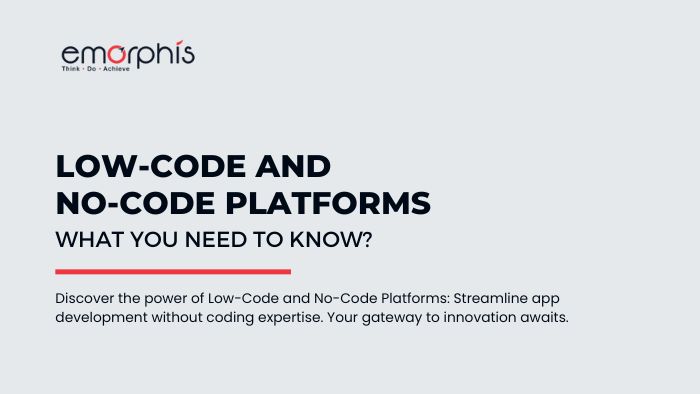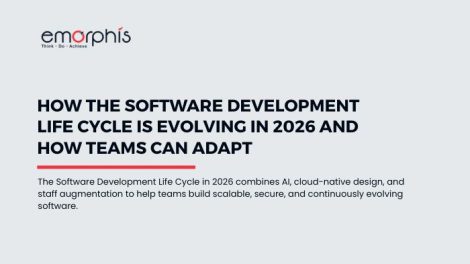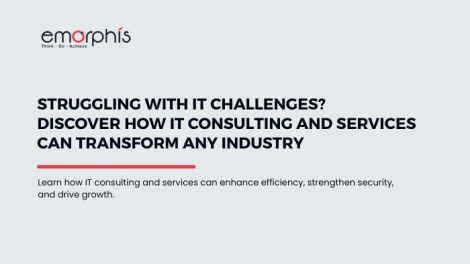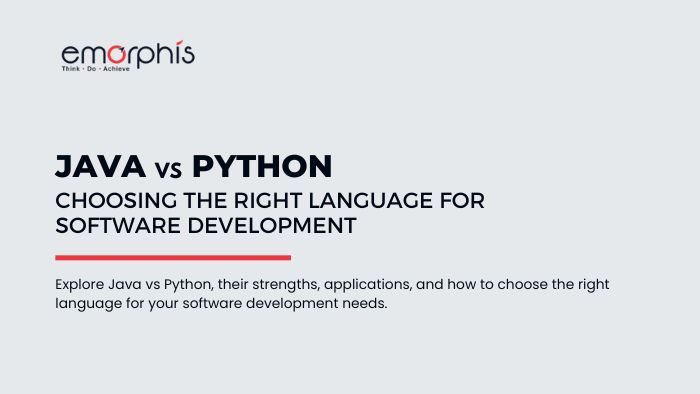In the fast-paced world of tech, where time is money and innovation is king, low-code and no-code platforms reign supreme. They’re the magic wands that let developers conjure up apps with a flick of the wrist while empowering anyone with a dream to turn ideas into digital reality—no coding chops required. Ready to explore this revolution in software creation?
Let’s go!
Overview
Low-code and no-code platforms have emerged as game-changers. These platforms enable users to create applications with minimal or no coding knowledge, significantly reducing the time and cost associated with traditional software development. Low-code platforms offer a graphical interface to design applications, requiring some basic coding for customization. In contrast, no-code platforms cater to non-technical users, allowing them to build applications entirely through visual components and pre-built templates.
The rise of these platforms has democratized app development, empowering a broader range of individuals and businesses to turn their ideas into functional software. According to a Gartner report, by 2024, low-code application development will account for more than 65% of all application development activity. This trend highlights the increasing significance and widespread adoption of low-code and no-code platforms within the tech sector.
As we delve deeper into why businesses are embracing these innovative tools, it becomes clear that the benefits extend far beyond mere convenience.
Why Businesses Are Adopting These Platforms
Businesses are rapidly adopting low-code and no-code platforms for several compelling reasons. One of the primary drivers is the significant reduction in development time. Traditional software development cycles can take months or even years, while low-code and no-code platforms can slash this time to weeks or days. This accelerated timeline allows businesses to be more agile and responsive to market changes.
Cost efficiency is another major factor. By reducing the need for extensive coding expertise, companies can save on hiring expensive development teams. According to Forrester reports, organizations using low-code platforms have seen an average ROI of 253% over three years. Additionally, these platforms enable rapid prototyping and iteration, allowing businesses to test and refine their applications quickly and cost-effectively.
Additionally, enabling non-technical staff, commonly known as “citizen developers,” to contribute is a significant advancement. Employees from various departments can create custom solutions tailored to their specific needs without relying on IT departments, fostering innovation and improving operational efficiency.
With these benefits in mind, it’s crucial to explore which platforms are leading the charge in this space. Let’s look at the best low code no code platforms in 2024.
Top Low-Code and No-Code Platforms in 2024
As we move into 2024, several low-code and no-code platforms stand out for their robust features and ease of use. These platforms are shaping the future of software development and are worth keeping an eye on.
- OutSystems – Known for its comprehensive suite of tools that support the entire application lifecycle, OutSystems is a leader in the low-code market. It offers a highly scalable environment and integrates seamlessly with existing systems.
- Mendix – Mendix provides a powerful platform for building multi-channel applications. Its AI-driven development environment accelerates the creation of complex applications while ensuring high-quality outputs.
- Microsoft Power Apps – Part of the Microsoft Power Platform, Power Apps enables businesses to create custom apps with minimal effort. Its integration with other Microsoft services, like Azure and Office 365, makes it a popular choice for enterprises.
- AppSheet – Acquired by Google, AppSheet is a no-code platform that allows users to build mobile and web applications directly from data sources like Google Sheets and Excel. Its intuitive interface ensures accessibility for non-technical users.
- Bubble – Bubble is a no-code platform that offers a wide range of features, including database management, workflows, and integrations. It’s particularly favored by startups and small businesses for its flexibility and affordability.
Selecting the right platform is just the beginning. Implementing these solutions effectively requires a strategic approach, which we’ll explore next.
Best Practices for Implementing Low-Code and No-Code Solutions in Your Business
Implementing low-code and no-code platforms successfully requires careful planning and execution. To ensure a seamless and efficient integration, consider these best practices.
- Identify Clear Use Cases – Start by identifying specific problems or processes that can benefit from low-code or no-code solutions. Prioritize applications that require quick development and are less complex to maximize the platforms’ advantages.
- Engage Stakeholders Early – Involve key stakeholders from various departments early in the process. Their input will be valuable in defining requirements and ensuring the solution meets user needs.
- Provide Training and Support – Even though these platforms are designed to be user-friendly, providing training can help your team maximize their potential. Offer workshops and ongoing support to help users become proficient.
- Establish Governance – Implement governance frameworks to manage the development and deployment of applications. This includes setting up guidelines for app design, data security, and compliance to maintain quality and consistency.
- Monitor and Iterate – Continuously monitor the performance of applications and gather user feedback. Use this information to make iterative improvements and ensure the solutions remain effective and relevant.
Adhering to these best practices allows businesses to fully leverage the capabilities of low-code and no-code platforms. But what does the future hold for traditional coding in this new landscape?
Will Low-Code and No-Code Replace Traditional Coding?
The question on many minds is whether low-code and no-code platforms will replace traditional coding. The short answer is no, but they will significantly alter the software development landscape.
Traditional coding will continue to be essential for building complex, highly customized applications that require deep technical expertise. However, low-code and no-code platforms will dominate areas where rapid development and deployment are critical. They will serve as complementary tools, allowing developers to focus on more challenging aspects of projects while empowering non-technical users to handle simpler tasks.
A Gartner report predicts that by 2024, 75% of large enterprises will be using at least four low-code development tools for both IT application development and citizen development initiatives. This shift indicates a growing recognition of the value these platforms bring but also underscores the continued need for traditional coding skills.
Understanding whether low-code or no-code is right for your business involves a nuanced approach, which we’ll delve into next.
Low-Code vs. No-Code – Which One Is Right for Your Business?
Selecting between low-code and no-code platforms relies on your specific business requirements and technical expertise. Here are some factors to consider when making your choice.
- Complexity of Applications – If your applications require extensive customization and integration with other systems, low-code platforms are likely the better choice. They offer more flexibility and control over the development process.
- User Expertise – For businesses with a significant number of non-technical users who need to create simple applications, no-code platforms are ideal. They provide an intuitive interface that allows anyone to build functional applications without coding knowledge.
- Speed of Development – Both low-code and no-code platforms offer rapid development, but no-code solutions are typically faster for straightforward applications. Low-code platforms, however, can handle more complex workflows and integrations at a slightly slower pace.
- Scalability – Consider the long-term scalability of your applications. Low-code platforms generally offer better scalability and are suitable for enterprise-level solutions, while no-code platforms are often better suited for small to medium-sized projects.
By evaluating these factors, you can make an informed decision that aligns with your business goals. As we look to the future, it’s important to consider how AI and machine learning are further enhancing these platforms.
Leveraging AI and Machine Learning in Low-Code and No-Code Platforms
The integration of AI and machine learning into low-code and no-code platforms is revolutionizing the way applications are developed. These technologies enhance the capabilities of the platforms, enabling more intelligent and efficient development processes.
AI-driven features, such as automated code generation, predictive analytics, and natural language processing, are becoming standard in many low-code and no-code platforms. For instance, platforms like Mendix and OutSystems are incorporating AI to provide real-time suggestions and optimizations during the development process, making it easier for users to create high-quality applications.
Moreover, machine learning algorithms can analyze user behavior and application performance, providing insights that help improve user experiences and operational efficiency. This integration allows for the development of more sophisticated applications that can adapt and evolve based on data-driven insights.
As AI and machine learning continue to advance, their role in low-code and no-code platforms will only grow, further blurring the lines between traditional and modern software development methods. This evolution underscores the transformative potential of these platforms in the tech industry.
Conclusion
In the evolving landscape of software development, low-code, and no-code platforms have emerged as transformative tools that democratize the creation of applications. These platforms empower businesses to rapidly develop solutions, reduce costs, and involve non-technical staff in the development process. With the integration of AI and machine learning, these platforms are becoming even more powerful, enhancing efficiency and innovation.
The adoption of low-code and no-code platforms is not just a trend but a fundamental shift in how software is developed. As businesses look to stay competitive, understanding the benefits and best practices for implementing these platforms is crucial. Whether you are a large enterprise looking to streamline complex workflows or a small business aiming to develop simple applications quickly, there is a platform to meet your needs.
At Emorphis Technologies, we specialize in helping businesses leverage the full potential of low-code and no-code platforms. Our expertise spans a wide range of industries and use cases, ensuring that our clients can innovate and grow efficiently. Connect with us today to learn how we can assist you in implementing these cutting-edge solutions to transform your operations and drive success.
Visit Emorphis Technologies to discover more about our services and how we can support your journey in adopting low-code and no-code platforms.
Further, click the link to read details on How Enterprise AI solutions transform business operations by utilizing artificial intelligence








